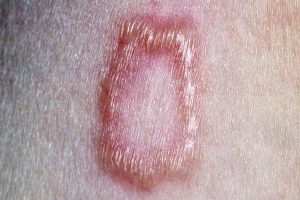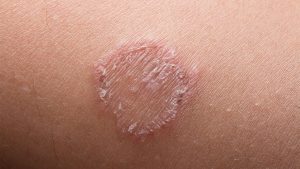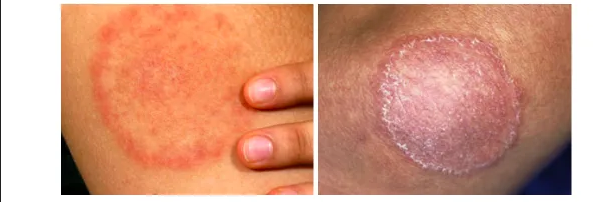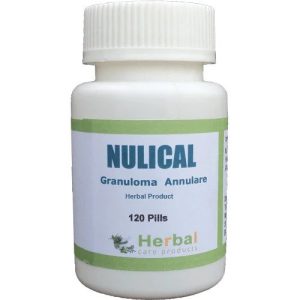No products in the cart.
Return To Shop 0 Cart $0.00 0
No products in the cart.
Return To Shop Shopping cart (0)
Subtotal: $0.00
Free shipping over 299$
Granuloma Annulare vs Ringworm: Symptoms, Treatments and More
Both granuloma annulare and ringworm can cause skin irritation and red, circular rashes that may look similar at a glance, but they are very different in origin, treatment, and prognosis. Understanding the distinctions between these two conditions can help in seeking the most effective treatment.
What is Granuloma Annulare?
Granuloma annulare is a chronic skin condition that results in reddish or skin-colored bumps forming in a circular or ring-like pattern. The cause of granuloma annulare is not completely understood, though it’s believed to be related to immune system responses. Unlike ringworm, granuloma annulare is not contagious.

What is Ringworm?
Ringworm, also known as tinea, is a fungal infection that can affect the skin, scalp, and nails. Despite its name, ringworm is not caused by a worm but by dermatophyte fungi that live on the outer layer of the skin. The infection is highly contagious and can spread through direct contact with an infected person, animal, or contaminated surfaces.

Symptoms of Granuloma Annulare vs Ringworm
Understanding the symptoms of granuloma annulare versus ringworm can help in differentiating the two conditions.
Granuloma Annulare Symptoms
- Appearance: Small, firm bumps that form a circular or ring-shaped pattern. These bumps are often skin-colored or red.
- Texture: Typically smooth to the touch.
- Location: Often appears on the hands, feet, elbows, or knees, but can occur on other body parts.
- Itchiness: Generally not itchy, although some people may experience mild discomfort.
Ringworm Symptoms
- Appearance: Red, circular rash with a raised, scaly edge and a clearer center, resembling a “ring.”
- Texture: Rough or scaly patches on the skin.
- Location: Can appear anywhere on the body, but is especially common on the scalp, feet, and groin.
- Itchiness: Usually very itchy, with possible scaling or cracking of the skin around the edges of the rash.
Causes and Risk Factors
The underlying causes of granuloma annulare and ringworm are quite different.
Granuloma Annulare Causes
- Immune Response: Granuloma annulare is thought to be an immune system reaction, though the exact cause remains unclear.
- Associated Conditions: In some cases, granuloma annulare has been linked with other medical conditions like diabetes or thyroid disease.
- Triggers: Physical trauma or insect bites may trigger granuloma annulare, though it’s not a direct cause.
Ringworm Causes
- Fungal Infection: Ringworm is caused by dermatophyte fungi, which thrive in warm, moist environments.
- Contagion: It is highly contagious and can spread through contact with infected individuals, animals, or contaminated objects like towels, clothing, and gym equipment.
- Risk Factors: Ringworm is common among athletes, especially wrestlers, due to close skin-to-skin contact and shared equipment. Pets, particularly cats and dogs, can also carry and spread ringworm.

Diagnosing Granuloma Annulare vs Ringworm
A dermatologist can help differentiate between granuloma annulare and ringworm by examining the rash and, if necessary, performing additional tests.
- Granuloma Annulare Diagnosis: Diagnosis is typically done through visual examination, though in some cases, a skin biopsy might be required to rule out other conditions.
- Ringworm Diagnosis: Diagnosis is usually confirmed by examining skin scrapings under a microscope, which will reveal the presence of fungi.
Treatment Granuloma Annulare vs Ringworm
The treatments for granuloma annulare and ringworm differ significantly due to their distinct causes.
Related Articles: Does Drinking Alcohol make Granuloma Annulare worse?
Granuloma Annulare Treatment
Granuloma annulare is a chronic skin condition characterized by raised, reddish or skin-colored bumps forming ring patterns on the skin, often on hands, feet, elbows, or knees. While this condition is typically benign and may resolve on its own, some cases can persist, causing discomfort or aesthetic concerns. Here’s an overview of treatment options:
1. Topical Corticosteroids
- Purpose: To reduce inflammation and manage symptoms.
- Application: Apply as prescribed to the affected area to help minimize the appearance and itching.
- Notes: Long-term use may cause skin thinning, so it’s often prescribed for short durations.
2. Intralesional Corticosteroid Injections
- Purpose: To target stubborn or larger lesions that don’t respond to topical treatment.
- Procedure: Injected directly into the lesion to reduce inflammation and promote healing.
- Considerations: Often administered by a dermatologist in a clinical setting.
3. Cryotherapy
- Method: Uses liquid nitrogen to freeze and reduce lesion size.
- Purpose: Helps in flattening the lesions by destroying affected tissue.
- Effectiveness: Works well for localized granuloma annulare but may require multiple sessions.
4. Phototherapy (Light Therapy)
- Options: PUVA (psoralen plus ultraviolet A) or narrow-band UVB light therapy.
- Purpose: To reduce inflammation and encourage lesion clearance, especially in widespread cases.
- Risks: May cause skin irritation or increase skin cancer risk with prolonged use.
5. Oral Medications
- Options: Certain medications, such as hydroxychloroquine, isotretinoin, or dapsone, may be prescribed for chronic or severe cases.
- Mechanism: These medications help reduce immune system activity, which can improve skin symptoms.
- Considerations: Regular monitoring is necessary due to potential side effects.
6. Natural and Home Remedies
Related Articles: Does Apple Cider Vinegar help Granuloma Annulare?
- Aloe Vera: Known for its soothing and anti-inflammatory properties, it can be applied to help with irritation.
- Turmeric: May be taken as a Herbal Supplements for Granuloma Annulare or applied as a paste for its anti-inflammatory benefits.
- Omega-3 Fatty Acids: Found in fish oil and flaxseed, omega-3s support skin health and may reduce inflammation.
7. Lifestyle and Dietary Adjustments
- Anti-inflammatory Diet: Include foods rich in antioxidants (like berries, leafy greens) and avoid processed foods that may worsen inflammation.
- Stress Management: Since stress can exacerbate skin conditions, practices like mindfulness, meditation, and regular exercise may help keep symptoms at bay.
8. Monitoring and Patience
- For many, granuloma annulare may resolve spontaneously within months or years. Regular dermatological check-ups can help monitor progression and determine the need for treatment adjustments.
If you’re experiencing persistent or uncomfortable symptoms, consulting a dermatologist will help you determine the best approach based on the size, location, and persistence of the lesions.
Related Articles: Can you get granuloma annulare from a food allergy?
Ringworm Treatment
Ringworm, also known as tinea, is a common fungal infection affecting the skin, scalp, or nails. Despite its name, it is not caused by a worm but by a fungus that thrives in warm, moist environments. Ringworm causes a red, itchy, ring-shaped rash that can spread if not treated properly. Here’s a guide to understanding effective treatment options for ringworm.
1. Topical Antifungal Creams and Ointments
- Over-the-Counter Options: Most cases of ringworm can be treated with antifungal creams, lotions, or powders available over the counter. Popular options include clotrimazole, miconazole, and terbinafine.
- Application: Apply the cream to the affected area twice daily for at least two weeks. Be sure to wash your hands after application to prevent spreading.
2. Prescription Antifungal Medications
- Stronger Medications: If ringworm is severe or does not respond to over-the-counter treatments, a doctor may prescribe stronger topical or oral antifungal medications.
- Common Prescriptions: Griseofulvin and terbinafine are often prescribed for difficult cases, especially for ringworm on the scalp or nails, which can be more stubborn.
3. Home Remedies for Mild Ringworm
- Tea Tree Oil: Known for its antifungal and antibacterial properties, tea tree oil may help in treating ringworm. Apply diluted tea tree oil (1 part oil to 3 parts carrier oil) to the affected area once or twice daily.
- Apple Cider Vinegar: The acidity of apple cider vinegar may help in killing the fungus. Dab it gently on the rash with a cotton ball a few times a day.
- Coconut Oil: This can be soothing and has mild antifungal effects, making it ideal for sensitive areas. Apply coconut oil to the rash several times daily.
4. Maintain Good Hygiene
- Keep the Area Clean and Dry: Since ringworm thrives in moist environments, it’s essential to keep the affected area as clean and dry as possible.
- Avoid Sharing Personal Items: Ringworm is contagious, so avoid sharing towels, clothes, or bedding with others.
- Wash Hands Frequently: Frequent hand washing can prevent the infection from spreading to other parts of your body or to others.
5. When to See a Doctor
- Persistent or Worsening Symptoms: If the ringworm rash is not improving after two weeks of treatment or if it continues to spread, consult a healthcare provider.
- Scalp and Nail Infections: Ringworm on the scalp or nails is harder to treat with topical solutions alone and typically requires oral antifungal medication.
Prevention Tips for Granuloma Annulare and Ringworm
Preventing Granuloma Annulare
Since granuloma annulare has no clear cause, prevention can be challenging. However, maintaining overall health and managing any associated conditions, like diabetes, may help reduce the risk of recurrence.
Preventing Ringworm
Because ringworm is highly contagious, prevention focuses on minimizing exposure to the fungus.
- Practice Good Hygiene: Regular handwashing and personal hygiene can prevent the spread of ringworm.
- Avoid Sharing Personal Items: Towels, clothes, and grooming tools should not be shared.
- Pet Care: Regularly inspect pets for signs of ringworm, and consult a veterinarian if you notice any lesions on your pets’ skin.
- Keep Skin Dry: Fungi thrive in moist conditions, so keeping skin dry and clean, especially after exercise, can help prevent infection.
Related Articles: Vitamin D Could Be the Key to Treating Granuloma Annulare
When to Seek Medical Advice
While granuloma annulare is generally harmless, it’s advisable to seek medical attention if the lesions spread, cause discomfort, or persist for several months. Ringworm, however, should be treated promptly to prevent spreading to others. If over-the-counter treatments for ringworm are ineffective after two weeks, consult a healthcare provider for stronger medications.
Key Takeaways
Granuloma annulare and ringworm can appear similar but have different causes and treatments. Granuloma annulare is a non-contagious condition often linked to immune responses, while ringworm is a highly contagious fungal infection. Knowing the differences in symptoms and treatment options can help in managing each condition effectively.
More
More

